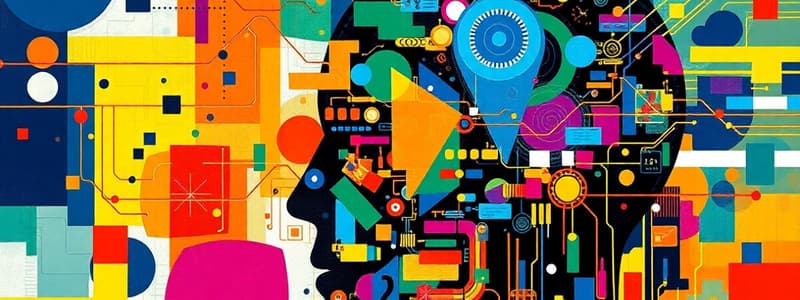Podcast
Questions and Answers
What capability is essential for a computer to communicate effectively with humans in the Turing Test?
What capability is essential for a computer to communicate effectively with humans in the Turing Test?
- Natural language processing (correct)
- Knowledge representation
- Automated reasoning
- Machine learning
Which of the following capabilities allows a computer to adapt to new circumstances?
Which of the following capabilities allows a computer to adapt to new circumstances?
- Cognitive modeling
- Machine learning (correct)
- Automated reasoning
- Computer vision
What additional capabilities does the Total Turing Test introduce compared to the standard Turing Test?
What additional capabilities does the Total Turing Test introduce compared to the standard Turing Test?
- Natural language processing and machine learning
- Question answering and dialogue
- Computer vision and robotics (correct)
- Knowledge representation and automated reasoning
Which aspect is crucial for a machine to achieve human-like behavior according to cognitive modeling?
Which aspect is crucial for a machine to achieve human-like behavior according to cognitive modeling?
According to the content, which of the following is NOT a requirement to pass the Turing Test?
According to the content, which of the following is NOT a requirement to pass the Turing Test?
What is a significant challenge in creating a computer model that mimics human thought?
What is a significant challenge in creating a computer model that mimics human thought?
What does automated reasoning allow a computer to do in the context of the Turing Test?
What does automated reasoning allow a computer to do in the context of the Turing Test?
To effectively store information, what capability must a computer possess?
To effectively store information, what capability must a computer possess?
What is a key focus of Artificial Intelligence?
What is a key focus of Artificial Intelligence?
Which element is NOT a component of Turing’s Test?
Which element is NOT a component of Turing’s Test?
What is required for a computer to be deemed intelligent in Turing's Test?
What is required for a computer to be deemed intelligent in Turing's Test?
Which of the following explicitly describes intelligent behavior?
Which of the following explicitly describes intelligent behavior?
What does the Turing Test measure?
What does the Turing Test measure?
Which characteristic is essential for a system to think rationally?
Which characteristic is essential for a system to think rationally?
What does 'acting humanly' refer to in the context of artificial intelligence?
What does 'acting humanly' refer to in the context of artificial intelligence?
Which of the following is NOT a method to achieve AI?
Which of the following is NOT a method to achieve AI?
What is one major ethical concern associated with the use of AI?
What is one major ethical concern associated with the use of AI?
What is a potential consequence of AI on the workforce?
What is a potential consequence of AI on the workforce?
What security risk is associated with increasingly sophisticated AI systems?
What security risk is associated with increasingly sophisticated AI systems?
Which of the following is a risk of biased decision making in AI?
Which of the following is a risk of biased decision making in AI?
What strategies are suggested to support individuals affected by job displacement due to AI?
What strategies are suggested to support individuals affected by job displacement due to AI?
Why is accountability a challenge in AI systems?
Why is accountability a challenge in AI systems?
What is a common criticism of using data in AI systems?
What is a common criticism of using data in AI systems?
What is an important measure to develop in response to AI security risks?
What is an important measure to develop in response to AI security risks?
What is one of the primary focuses of control theory in the context of AI?
What is one of the primary focuses of control theory in the context of AI?
Which event is associated with the birth of the term 'Artificial Intelligence'?
Which event is associated with the birth of the term 'Artificial Intelligence'?
During the period from 1988 to 1993, what major trend occurred in the AI industry?
During the period from 1988 to 1993, what major trend occurred in the AI industry?
What application of AI is associated with the technology used in driverless cars?
What application of AI is associated with the technology used in driverless cars?
Which topic is NOT identified as a main area of focus within AI?
Which topic is NOT identified as a main area of focus within AI?
What characterizes the resurgence of AI known as 'AI Spring'?
What characterizes the resurgence of AI known as 'AI Spring'?
Which AI application is specifically designed for task automation in communication?
Which AI application is specifically designed for task automation in communication?
Which of the following systems is an example of AI used for personal assistance?
Which of the following systems is an example of AI used for personal assistance?
What distinguishes systems that think rationally from those that think like humans?
What distinguishes systems that think rationally from those that think like humans?
Which statement best describes a 'Rational Agent'?
Which statement best describes a 'Rational Agent'?
What is a significant drawback when using formal logic to represent knowledge?
What is a significant drawback when using formal logic to represent knowledge?
How does the concept of syllogism relate to logical reasoning?
How does the concept of syllogism relate to logical reasoning?
Which area is NOT directly related to the principles of rationality outlined in the content?
Which area is NOT directly related to the principles of rationality outlined in the content?
What is the primary focus of systems that act rationally?
What is the primary focus of systems that act rationally?
In terms of decision theory, what does it mean to decide under uncertainty?
In terms of decision theory, what does it mean to decide under uncertainty?
Which aspect of psychology is relevant to the study of rational systems?
Which aspect of psychology is relevant to the study of rational systems?
What is defined as the ability to learn about, understand, and interact with one’s environment?
What is defined as the ability to learn about, understand, and interact with one’s environment?
Which of the following accurately describes Artificial Intelligence?
Which of the following accurately describes Artificial Intelligence?
Which characteristic is NOT associated with intelligent systems?
Which characteristic is NOT associated with intelligent systems?
What is a primary goal of AI development?
What is a primary goal of AI development?
Which of the following is a necessary capability for intelligent systems?
Which of the following is a necessary capability for intelligent systems?
Which of the following is a characteristic of intelligence?
Which of the following is a characteristic of intelligence?
What is one approach to AI that focuses on modeling human cognitive processes?
What is one approach to AI that focuses on modeling human cognitive processes?
Which concept relates to how intelligent systems evolve their performance over time?
Which concept relates to how intelligent systems evolve their performance over time?
Flashcards
Turing Test
Turing Test
The Turing Test is a method for determining if a machine can exhibit intelligent behavior indistinguishable from a human. It involves a human interrogator interacting with both a human and a machine, trying to distinguish between them based on their responses.
What does the Turing Test measure?
What does the Turing Test measure?
The Turing Test evaluates a machine's ability to mimic human-like conversation, making it a test of intelligence.
How does a machine pass the Turing Test?
How does a machine pass the Turing Test?
To pass the Turing Test, a machine must be able to respond to questions in a way that is indistinguishable from a human, making it seem intelligent.
Describe the setup of a Turing Test.
Describe the setup of a Turing Test.
Signup and view all the flashcards
Why is the Turing Test important?
Why is the Turing Test important?
Signup and view all the flashcards
What is the goal of the Turing Test?
What is the goal of the Turing Test?
Signup and view all the flashcards
What is Intelligence?
What is Intelligence?
Signup and view all the flashcards
What is Artificial Intelligence (AI)?
What is Artificial Intelligence (AI)?
Signup and view all the flashcards
Characteristics of Intelligence
Characteristics of Intelligence
Signup and view all the flashcards
A Hierarchical Model of Intelligence
A Hierarchical Model of Intelligence
Signup and view all the flashcards
What Intelligent Systems Should Do?
What Intelligent Systems Should Do?
Signup and view all the flashcards
What does AI involve?
What does AI involve?
Signup and view all the flashcards
Learning from Experience
Learning from Experience
Signup and view all the flashcards
Flexibility in Dealing with Variability
Flexibility in Dealing with Variability
Signup and view all the flashcards
Natural Language Processing
Natural Language Processing
Signup and view all the flashcards
Knowledge Representation
Knowledge Representation
Signup and view all the flashcards
Automated Reasoning
Automated Reasoning
Signup and view all the flashcards
Machine Learning
Machine Learning
Signup and view all the flashcards
Total Turing Test
Total Turing Test
Signup and view all the flashcards
Computer Vision
Computer Vision
Signup and view all the flashcards
Robotics
Robotics
Signup and view all the flashcards
What is the Turing Test?
What is the Turing Test?
Signup and view all the flashcards
Rational Systems
Rational Systems
Signup and view all the flashcards
Laws of Thought Approach
Laws of Thought Approach
Signup and view all the flashcards
Syllogism
Syllogism
Signup and view all the flashcards
Rational Agent
Rational Agent
Signup and view all the flashcards
Psychology/Cognitive Science in AI
Psychology/Cognitive Science in AI
Signup and view all the flashcards
Neuroscience in AI
Neuroscience in AI
Signup and view all the flashcards
Mathematics in AI
Mathematics in AI
Signup and view all the flashcards
Economics in AI
Economics in AI
Signup and view all the flashcards
What is a risk of AI bias?
What is a risk of AI bias?
Signup and view all the flashcards
What are security risks associated with AI?
What are security risks associated with AI?
Signup and view all the flashcards
What is the risk of job displacement due to AI?
What is the risk of job displacement due to AI?
Signup and view all the flashcards
What are ethical concerns about AI development?
What are ethical concerns about AI development?
Signup and view all the flashcards
Define Natural Language Processing (NLP)
Define Natural Language Processing (NLP)
Signup and view all the flashcards
Study Notes
Introduction to Artificial Intelligence
- This topic introduces the fundamental concepts of Artificial Intelligence (AI)
- The course is for Term 2, ARTI 106, Computer Track, 2024-2025.
Learning Outcomes
- Define and give examples of basic AI concepts.
- Identify the goals of AI
- Identify approaches to AI.
- Identify problems suitable for AI techniques.
Outline
- What is AI?
- Approaches to AI
- A brief history of AI.
- Applications of AI.
- Main topics in AI
- Challenges and Risks of AI
What is Intelligence?
- The ability to learn about, learn from, understand, and interact with one's environment.
- Understanding is key, but not avoiding mistakes.
- Key Characteristics include: ability to communicate, creativity, ability to learn, knowledge of oneself and the world, goal-directed, and self-awareness
A Hierarchical Model of Intelligence
- A model with a pyramid structure
- Data is the base layer.
- Context, experience, and vision lead to knowledge
- and wisdom is the highest level.
What Is Artificial Intelligence?
- AI refers to simulating human intelligence in machines
- These machines are programmed to think and learn.
- AI involves developing algorithms and computer programs to perform tasks typically requiring human intelligence. This includes visual perception, speech recognition, decision-making, and language translation.
What Intelligent Systems Should Do
- Perform tasks typically done by experts.
- Be more autonomous with reduced need for intervention or monitoring.
- Be flexible to accommodate environmental variability.
- Be user-friendly and understand user intent from limited instructions.
- Improve performance through learning from experience.
Test Your Knowledge (Questions and Answers)
- Question 1: Identifying non-characteristics of intelligent systems. The correct answer is dependence on constant human monitoring
- Question 2: What enables intelligent systems to be easier to use? Ability to understand user intent from limited instructions is the correct answer.
What Is Artificial Intelligence? (Alternative Definitions)
- Reproduction of the methods and results of human reasoning.
- A branch of Computer Science concerned with automating intelligent behavior.
- The design of intelligence within artificial devices.
- A field of computer science that simulates human performance to enable computers to reason like humans.
Four Main Approaches to Artificial Intelligence
- Thinking Humanly (cognitive modeling)
- Thinking Rationally (laws of thought)
- Acting Humanly (Turing Test)
- Acting Rationally (rational agent)
How to Achieve AI?
- A table defining four categories:
- Thought (human-like thinking, rational thinking)
- Behaviour (human-like action, rational action).
Acting Humanly (Turing Test)
- A test to determine if a machine can exhibit intelligent behavior similar to humans.
- The test involves a human evaluator interacting with both a human and a machine.
- If the evaluator cannot reliably distinguish between the responses of the human and the machine, the machine is said to have passed the Turing Test.
Turing Test Example
- The method involves a human questioner, a computer, and another human answering questions.
- The goal is for the human questioner to not be able to tell whether they are interacting with a human or a machine.
Systems that act like humans
- Human questioners can test machine's ability, through a teletype system, to pass the Turing test.
- The computer must exhibit human-level cognitive task performance
- Key capabilities for passing include natural language processing, knowledge representation, automatic reasoning, and machine learning.
- The Turing Test excludes physical interaction
- Requirements for objects include computer vision and robotics.
Test Your Knowledge (Turing Test)
- Question 1: Correct answer involves a scenario where the human cannot tell if they are interacting with a human or a machine through remote communication.
Systems that Think Rationally
- Rationality: making optimal decisions in situations based on available information.
- Focus is on logical rules and formal representation, not necessarily mimicking human thought.
- Syllogism: a form of deductive reasoning used to determine deductions from facts/definitions, such as the Socrates example.
Rational Agent
- An agent that acts to achieve the best or expected outcome when confronted with uncertainty or several factors.
- Rational behavior entails making accurate decisions and executing the optimal actions.
Relations to Other Fields
- Draws on philosophy (logic, methods of reasoning), mathematics (formal representation, algorithms), economics (decision theory), neuroscience (information processing units), psychology (human behaviour and cognitive processes).
- Relevant areas include computer engineering (building fast computers) control theory (systems optimization), and linguistics (grammar and representation of knowledge).
A (Short) History of AI
- Covers various eras, including early days (1940s-1950s), excitement of early programs (1950s-1970s), knowledge-based approaches (1970s-1990s), resurgence of statistical approaches (1990s-2012).
- Recent years have seen renewed interest in neural networks and big data.
Applications of AI
- AI powers numerous applications such as language translation, news aggregation, speech and song recognition, image and face recognition, question answering, 3D scene construction from images, driverless cars, chatbots, and augmented reality.
State of AI Systems in Practice
- AI is now used in email communications, social media, web searching, and stores/services.
The main topics in AI
- Covers core areas like knowledge representation, reasoning, search, problem solving, learning, pattern recognition, planning, and interacting with the environment (e.g., vision, speech recognition, robotics)
- Includes expert systems, a significant area.
Challenges and Risks of AI
- Ethical concerns such as privacy, bias (in algorithms/data), and accountability.
- Job displacement due to automation.
- Security risks of sophisticated systems becoming vulnerable to cyber-attacks.
- Biased decisions made in applications such as loan decisions or parole decisions.
Questions
- Various questions related to defining intelligence, approaches to AI, Turing Test design, relationship between AI and natural intelligence. AI’s projected 5 and 10-year capabilities.
Studying That Suits You
Use AI to generate personalized quizzes and flashcards to suit your learning preferences.
Related Documents
Description
This quiz will cover the fundamental concepts of Artificial Intelligence as part of the ARTI 106 course for Term 2 of the Computer Track, 2024-2025. You will explore different approaches, applications, and the historical development of AI, along with its challenges and risks.




